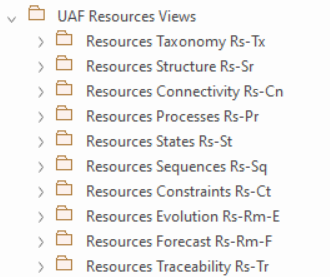| Prev | Next |
UAF Resources Views
The UAF Resource Views include viewpoints that focus on the physical systems and broader resources an organization relies on to accomplish its work, as well as the artifacts associated with those resources. They represent an evolution of the traditional Systems domain used in frameworks such as DoDAF, NAF, MODAF, and DNDAF. These viewpoints examine how services are implemented across different phases, and how their deployment alters system configurations at an enterprise level. By providing a structured framework for modeling both the physical and logical components that enable organizational capabilities, the Resource Views allow architects to analyze dependencies, relationships, and interactions among resource artifacts. This holistic perspective supports a thorough understanding of the systems and resources that underpin an organization’s mission and operational needs.

UAF Resources Views
|
Resources Taxonomy Rs-Tx |
Stakeholders: Solution Providers, Systems Engineers, IT Architects, Implementers. Concerns: Resource types. Definition: Shows the taxonomy of types of resources. |
|
Resources Structure Rs-Sr |
Stakeholders: Systems Engineers, Resource Owners, Implementers, Solution Providers. Concerns: Reference the resource structure, connectors, and interfaces in a specific context. Definition: Defines the physical resources, e.g., capability configuration(s)/system(s) and interactions necessary to implement a specific set of OperationalPerformer(s). Can be used to represent communications networks and pathways that link communications resources and provides details regarding their configuration. |
|
Resources Connectivity Rs-Cn |
Stakeholders: Systems Engineers, IT Architects, Solution Providers, Implementers. Concerns: Capture the interactions between resources. Definition: Summarizes interactions between resources of information, systems, personnel, natural resources, etc. and the functions that produce and consume them. Measurements can optionally be included. |
|
Resources Processes Rs-Pr |
Stakeholders: Solution Providers, Systems Engineers, IT Architects. Concerns: Captures activity based behavior and flows. Definition: Describes the functions that are normally conducted in the course of implementing operational activity(ies) in support of capability(ies). It describes the functions, their Inputs/Outputs, function actions, and flows between them. |
|
Resources States Rs-St |
Stakeholders: Systems Engineers, Software Engineers. Concerns: Capture state-based behavior of a resource. Definition: It is a graphical representation of states of a resource and how that resource responds to various events and actions. |
|
Resources Sequences Rs-Sq |
Stakeholders: Software Engineers, Systems Engineers. Concerns: Interactions between resources (roles). Definition: Provides a time-ordered examination of the interactions between resources. |
|
Resources Constraints Rs-Ct |
Stakeholders: Systems Engineers, IT Architects, Solution Providers, Implementers. Concerns: Define limitations, constraints and performance parameters for resources, their interactions, performed functions, and data. Definition: Specifies traditional textual rules/non-functional requirements that are constraints on resources, their interactions, performed functions, and data. The addition of SysML parametrics provide a computational means of defining resource constraints within a specific context. |
|
Resources Evolution Rs-Rm-E |
Stakeholders: Systems Engineers, IT Architects, Solution Providers, Implementers. Concerns: Resource structure changes over time. Definition: Provides an overview of how a resource structure changes over time. It shows the structure of several resources mapped against a timeline. |
|
Resources Forecast Rs-Rm-F |
Stakeholders: Solution Providers, Systems Engineers, IT Architects. Concerns: Technology forecast. Definition: Defines the underlying current and expected supporting technologies. Expected supporting technologies are those that can be reasonably forecast given the current state of technology and expected improvements / trends. |
|
Resources Traceability Rs-Tr |
Stakeholders: Systems Engineers, Enterprise Architects, Solution Providers, Business Architects. Concerns: traceability between operational activities and functions that implements them. Definition: depicts the mapping of functions to operational activities and thus identifies the transformation of an operational need into a purposeful function performed by a resource or solution. |